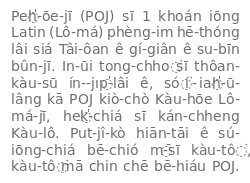Pe̍h-oē-jī
|
Pe̍h-ōe-jī Church Romanization |
|
|---|---|

A sample of pe̍h-ōe-jī text
|
|
| Type |
Latin alphabet (modified)
|
| Languages | |
| Creator |
Walter Henry Medhurst Elihu Doty John Van Nest Talmage |
|
Time period
|
1830s–present |
|
Child systems
|
TLPA Taiwanese Romanization System |
| Pe̍h-ōe-jī | |||||||||||||||||||||||||||||||||||||
| Traditional Chinese | 白話字 | ||||||||||||||||||||||||||||||||||||
|---|---|---|---|---|---|---|---|---|---|---|---|---|---|---|---|---|---|---|---|---|---|---|---|---|---|---|---|---|---|---|---|---|---|---|---|---|---|
| Simplified Chinese | 白话字 | ||||||||||||||||||||||||||||||||||||
| Hokkien POJ | Pe̍h-ōe-jī | ||||||||||||||||||||||||||||||||||||
| Literal meaning | Vernacular writing | ||||||||||||||||||||||||||||||||||||
|
|||||||||||||||||||||||||||||||||||||
| Transcriptions | |
|---|---|
| Standard Mandarin | |
| Hanyu Pinyin | Báihuà zì |
| Wu | |
| Romanization | Poe平 ho入 zî平 |
| Gan | |
| Romanization | Pha̍k-oa-chhi |
| Hakka | |
| Romanization | Pha̍k-fa-sṳ |
| Yue: Cantonese | |
| Yale Romanization | baahk wá jih |
| Jyutping | baak6 wa2 zi6 |
| Southern Min | |
| Hokkien POJ | Pe̍h-ōe-jī |
| Teochew Peng'im | Pêh-uē-jī |
| Hainanese Romanization | Bǽh-oe-tu |
| Eastern Min | |
| Fuzhou BUC | Bàng-uâ-cê |
Pe̍h-ōe-jī (pronounced [peʔ˩ ue˩ dzi˨], abbreviated POJ, literally vernacular writing, also known as Church Romanization) is an orthography used to write variants of Southern Min Chinese, particularly Taiwanese Southern Min and Amoy Hokkien. Developed by Western missionaries working among the Chinese diaspora in Southeast Asia in the 19th century and refined by missionaries working in Xiamen and Tainan, it uses a modified Latin alphabet and some diacritics to represent the spoken language. After initial success in Fujian, POJ became most widespread in Taiwan and, in the mid-20th century, there were over 100,000 people literate in POJ. A large amount of printed material, religious and secular, has been produced in the script, including Taiwan's first newspaper, the Taiwan Church News.
During Taiwan under Japanese rule (1895–1945), the use of Pe̍h-ōe-jī was suppressed and it faced further countermeasures during the Kuomintang martial law period (1947–1987). In Fujian, use declined after the establishment of the People's Republic of China (1949) and in the early 21st century the system was not in general use there. Taiwanese Christians, non-native learners of Southern Min, and native-speaker enthusiasts in Taiwan are among those that continue to use Pe̍h-ōe-jī. Full native computer support was developed in 2004, and users can now call on fonts, input methods, and extensive online dictionaries. Rival writing systems have evolved, and there is ongoing debate within the Taiwanese mother tongue movement as to which system should be used. Versions of pe̍h-ōe-jī have been devised for other Chinese varieties, including Hakka and Teochew Southern Min.
...
Wikipedia
